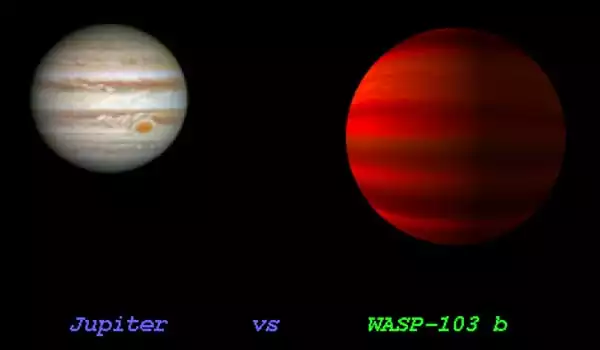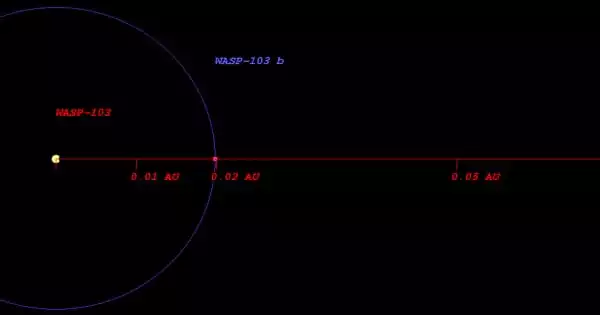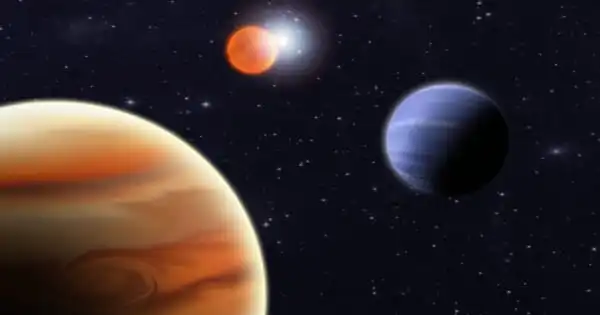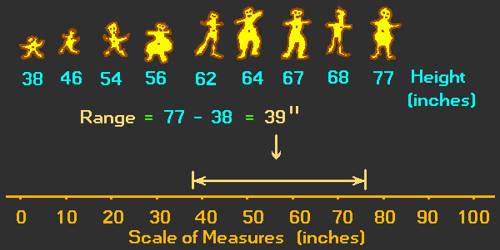WASP-103 b is a gas giant exoplanet in the habitable zone of an F-type star. It has a mass of 1.49 Jupiters, takes 0.9 days to complete one orbit of its star, and is located 0.01985 AU away from it. It was discovered in 2014, and its discovery was announced.
WASP-103 b is an exoplanet that orbits the star WASP-103, which is located approximately 1532.9 light-years (470.0 pc) from our Solar System. Its discovery was made public in 2014. WASP-103 has an apparent magnitude of 12.0 and an absolute magnitude of 3.6. It is 1.2 times more massive and 1.4 times larger than our Sun. The surface temperature is 6110 degrees Fahrenheit, and the spectral type is F8V. WASP-103 b, an extrasolar planet in this planetary system, orbits the star WASP-103 every 0.9 days at an orbital distance of 0.02 AU.
WASP-103b is an oval-shaped planet discovered by the European Space Agency’s CHEOPS (CHaracterising ExOPlanets Satellite) space observatory, which was deployed in 2019 to study exoplanets. WASP-103b is the first non-sphere exoplanet discovered among the 4,500 or so discovered so far. It’s a “ultrahot Jupiter” gas giant exoplanet with an ultra-short period. WASP-103b orbits its F-type star every 0.9 days, which is around 50 times closer to its star than Earth is to the Sun. That qualifies it as a “star-hugger.” It’s located in the constellation Hercules, 1,225 light-years away.
They did this by waiting for WASP-103b to pass in front of its host star from the perspective of the CHEOPS telescope, a process known as a transit, and then used the transit light curve to determine how mass is distributed within the planet.

Strong tidal forces between the planet and its host star distort WASP-103b into its rugby ball shape. The scientists were also able to determine how much of WASP-103b is rocky, gaseous, and water by analyzing how much of the planet is distorted. X WASP-103b, on the other hand, remains a mystery. WASP-103b was found to have statistics comparable to Jupiter, implying that it has a similar interior structure despite having twice the radius.
Given the exoplanet’s proximity to the sun, researchers assumed WASP-103b had significant potential for deformation. Its orbit around the host star WASP-103 completes one revolution in less than a day on Earth. This causes its tides to be exceptionally powerful, effectively changing the mass of WASP-103b. The strange oval exoplanet can theoretically teach us more about similar worlds and how they form. WASP-103b’s composition is of significant importance for two reasons. For starters, the exoplanet appears to be particularly bloated, which may reveal more about gas giants and their behavior.
Exoplanet mission of the European Space Agency Cheops discovered that an exoplanet orbiting its host star within a day has a distorted shape more resembling a rugby ball than a sphere. WASP-103b is a planet in the constellation Hercules. It has been warped by the tremendous tidal forces between the planet and its host star, WASP-103, which is around 200 degrees hotter and 1.7 times larger than the Sun.
















